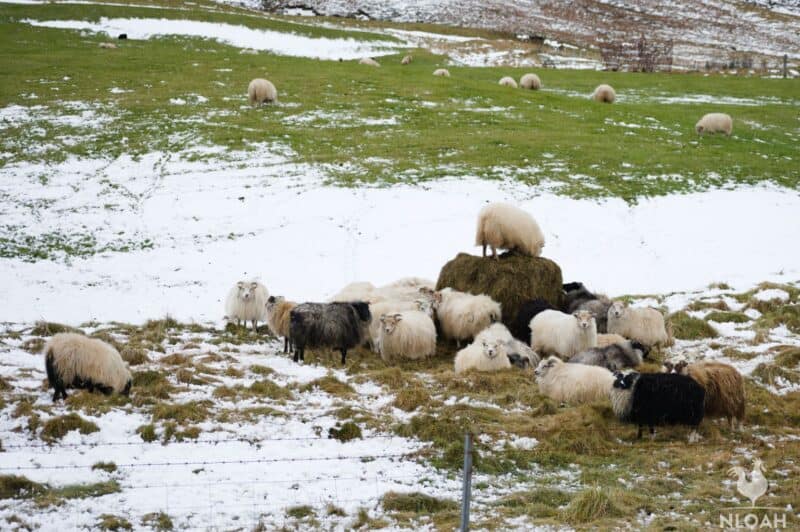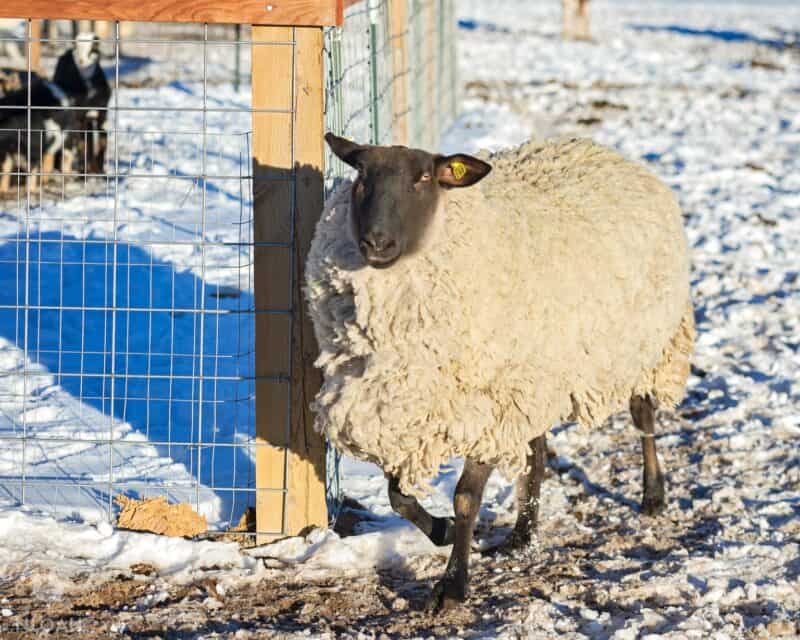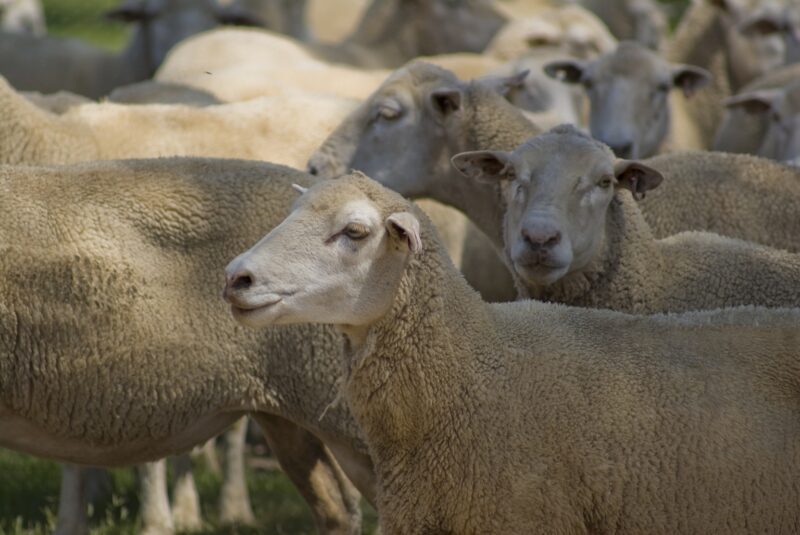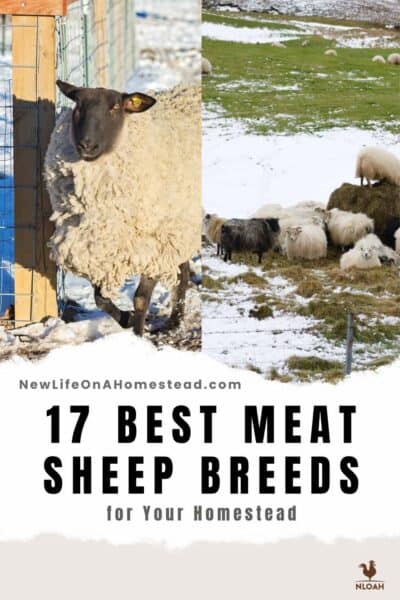If you want the pound-for-pound most versatile livestock animals you own, you’ve got to get sheep. Sheep produce wool, of course, and also delicious, rich, smooth milk. But they’re also an important source of meat, and have long been kept and raised around the world for the purpose.
Lamb and mutton isn’t that popular here in the US, but sheep still have many advantages for homesteaders specifically, especially compared to more common meat-producing species.
They grow a lot quicker than cows, are much easier to handle, and are more affordable overall. Plus, their meat is delicious, and there’s a growing market for sheep meat generally.
If you want to have a good time rearing a flock of your own for meat, you’ll need to pick the right breed. The good news is there are plenty of good choices, and I’m here to tell you about 17 of the very best meat breeds. We’ll get right into it below.

Icelandic
Remarkably healthy, independent, and exceptionally fertile, Icelandics are a unique breed that can be a little tricky to handle owing to their skittishness and wild tendencies, but they make growing your flock and replacing harvested animals really easy.
They are slow growers, but the quality of their meat makes them worth a little bit of patience.
This breed, more than most, tends to be quite athletic and lean and their meat is often described as rich and intensely flavored if they are allowed to free range.
To be honest, the flavor is a love-or-hate sort of thing, with some folks greatly liking it while others detest it. But there’s no denying that the Icelandic is an important breed for mutton and lamb production.
Rambouillet
The Rambouillet breed is closely related to the world-famous Merino sheep, known for the incomparable quality of its wool. These guys are true dual-use sheep, however, being raised for meat and also for wool. Theirs isn’t quite as good as their more famous cousins, but still respectable.
When it comes to meat, though, Rambouillets have Merinos beat hands down thanks to superior carcass yield and their better grazing tendencies. These sheep can live quite happily even on a pasture of only mediocre quality.
Romney
A dual-use breed that is famously calm, easy to handle, and easy to care for, Romneys are alternately kept for wool, meat, or both.
They’re highly recommended for meat since they consistently produce cuts that are very mild and clean tasting, even in the case of older adults that are harvested for mutton.
Ask anyone who has tried meat from an older sheet before and they can tell you it is often unpleasant compared to lamb.
This trait gives you more flexibility when slaughtering older Romneys to manage your flock. You won’t be forced to raise them at a breakneck pace from birth to three or four months before harvesting. A nice perk!
Katahdin
A unique and popular meat breed, Katahdin sheep are known for their excellent performance in hot weather thanks to their hair coat.
That’s right; this American sheep doesn’t grow wool at all. When you aren’t walking around in a thick wool coat it is a lot easier to stay cool in arid conditions! Who would have thought?
This breed is also highly regarded for its good health and vitality overall, though they do tend to grow slower than other breeds. Even so, they’re usually ready to slaughter anywhere from 12 to 14 weeks.
But that isn’t the only reason why Katahdins are so respected. Even though they are on the smaller side of the spectrum when it comes to large breeds, weighing around 250 pounds when fully grown, their meat is known to be lean and delicious. Furthermore, it’s notably free of any disagreeable flavor sometimes associated with mutton.
This is a great breed if you live in a hot region or just don’t want to mess around with wool at all.
Dorset
The Dorset, not to be confused with the Dorper elsewhere on our list, is an English breed with a sterling reputation as a true multipurpose sheep. These domestics have been with us for over 300 years, and at different times have been raised for meat but also wool and milk.
Their wool is said to be of uniformly excellent quality and they’re likewise known to be reliable milkers. Best of all, they are famously docile and easy to manage. No wonder people love them!
When it comes to meat particularly they don’t disappoint, though there’s a significant size variation between males and females. Mature rams are usually around 300 pounds, but the ladies are significantly lighter, anywhere from 150 to 200 pounds.
Their meat is rich, relatively high in fat, and tender. Dorsets are an inspired choice for meat or as an all-purpose sheep.
Cheviot
Short, stout, muscular, and extraordinarily resistant to blisteringly cold weather, the Cheviot also hails from England like so many other meat-producing sheep breeds.
Although they’re a medium-sized breed, they are well regarded for their excellent carcass yield and also ample production of milk.
If you live on rough or broken terrain, especially in a colder region, this breed is one of the very best since they are at home in steep areas. The quality of their meat is said to be flavorful, somewhat fatty, and tender.

Suffolk
These popular, ubiquitous domestic sheep are massive, and one of the most important producers of lamb and mutton raised around the globe. Yet another English breed on our list- and not the last! – Suffolks grow very quickly and also reach extreme size… Believe it or not, mature males can clear 500 pounds!
If you are raising sheep for meat, this rapid growth and extra large carcass means you can be raking in a huge haul of lamb and mutton.
It isn’t a matter of quantity over quality, either: their meat is well regarded the world over for its flavor and overall quality. So what’s the downside? Great big sheep have great big appetites, so you’ll be spending a lot more on food accordingly!
Welsh Mountain
In case the name didn’t tip you off, the Welsh Mountain sheep comes from South Wales. Though small in size, they are hardy, adaptable, and have excellent health overall.
They also do great and steep, broken terrain and they tend to be supremely athletic. A dual-use breed, they are kept for both meat and milk, and ewes are good mothers and easy to breed.
The drawbacks with these sheep are that they’re highly agile, and also such good climbers and jumpers the’are difficult to keep contained.
Barbados Blackbelly
Compared to some of the other larger breeds on our list, the relatively scrawny Barbados Blackbelly looks like a poor choice at best.
At their very largest, these sheep usually weigh no more than 130 pounds or so, and they also grow quite slowly. That’s a bad combination for a meat breed, right? Normally yes, but not in this case!
These sheep are amazingly fertile and highly reliable breeders; a healthy, young ewe in her prime will usually have two to three lambs at a time.
This means you can grow your flock exponentially if you want to! Even better, despite their small carcass yield their meat is known to be exceptionally tasty.
The Barbados Blackbelly will also reliably breed all year long, and is famously resistant to disease and parasites in particular. That means lower healthcare costs and stress for you. This breed is one of the very best if you want maximum control over your breeding operation.

Dorper
A rugged, adaptable heritage breed that is most known for its year-round breeding behavior and its naturally shedding wool, Dorpers are seeing renewed interest in recent decades as a meat breed.
They’re certainly sizable enough, with males weighing around 300 pounds and ewes coming in at anywhere from 240 to 250 pounds, though some of the ladies weigh significantly less.
And as a meat breed, it is that unique tendency to drop their wool that makes them so interesting. Sheep wool normally creates a compound called lanolin.
Though natural, it will often taint the meat of sheep with a distinctly nasty taste. Because Dorpers produce very little lanolin, their meat is known for being exceptionally clear, bright, and flavorful.
Hampshire
Hampshires are a remarkably great breed to keep for meat. Hailing from England, they grow big, often reaching 300 pounds, and they grow fast. Ultimately they yield lots of tender, lean meat whether they are slaughtered for lamb or mutton.
Another interesting characteristic associated with Hampshires is that they’re routinely used to strengthen the lineage of sheep in breeding programs. They themselves were originally the product of crossbreeding in the 1800s using Leicester and Southdown sheep.
Texel
One of the most interesting meat breeds on our list, the Texel is fairly small in overall size compared to some of the other giants we have featured here, but they have an incredibly dense and heavily muscled build that makes them a natural choice for meat.
Carcass yields are typically excellent, and they grow quickly and breed readily, though they don’t breed all year round.
You won’t go wrong with the Texel as long as you live in a cool or temperate region: their heavy wool coats put them at a distinct disadvantage in arid climates. Overheating is a problem, and shearing will be a necessary chore.
Tunis
There are heritage breeds, and then there are venerable breeds, and the Tunis is the latter. These sheep can genuinely be said to hail from the old world and are almost completely unchanged from those ancient days.
Although they are another smaller breed on our list, their excellent fertility and mothering instincts mean that you’ll reliably be able to replace losses and expand your flock as needed, though they have a relatively short breeding season you’ll have to work around.
Their meat is considered a true delicacy these days, particularly lamb, and the flavor is said to be second to none. Definitely a cool choice if you’re going to raise sheep for meat!
Southdown
An English dual-use breed, the Southdown has been kept for both wool and meat for centuries, though it has only been in the Western hemisphere for a comparatively short time, about 200 years.
The reason they remained so enduringly popular is for the great taste and overall quality of their meat, which is said to be perfectly rich and fatty, but also because of their remarkable adaptability.
They can live in hot climates or cold ones, put up with dry spells or wet conditions. Nothing keeps them down, and they are excellent grazers. Truly a superb breed that’s easy to manage!
Charollais
The Charollais is a massively built sheep. Broad, stocky, and heavy, you can tell at a glance that they are destined for meat production. And you’d be right!
Long used in France, where they come from, for exactly that purpose – but also in breeding programs to increase the size and musculature of other breeds.
This is another sheep you can count on for a large carcass yield but also rapid growth. If they have one drawback, it is the fact that they need lots of food and also high-quality pasture if you’re going to let them free-range.
Make sure you perform a nutritional analysis on your land before you commit to these big boys!
Shropshire
The Shropshire is a well-regarded sheep that is known for its long lifespan and its excellent production of both meat and wool. This is a specialty breed that’s sought out for the quality of its lamb and mutton, which is said to be rich, tender, and savory.
Interestingly, considering this is another English domestic breed, their precise origins are shrouded in mystery.
Regardless, they’re a fine choice if you want to keep a flock for meat, though they tend to have big appetites for their size so you have to budget for extra food and make sure you have ample pasture for them.
Border Leicester
Another English breed, and another dual-use one, Border Leicesters were first developed in the mid-18th century and have been kept ever since for wool and meat.
Interestingly, they have a sloping, almost drooping face and muzzle which gives them a unique look in conjunction with their thin, upright ears. At a glance, they look almost like giant rabbits!
Funny looks aside, these large sheep are excellent breeders, easy to handle, and reliable producers of succulent, delicious lamb and mutton alike. They grow somewhat quicker than most other breeds, but their large size and heavy build means they will need more food.

Tom has lived and worked on farms and homesteads from the Carolinas to Kentucky and beyond. He is passionate about helping people prepare for tough times by embracing lifestyles of self-sufficiency.
